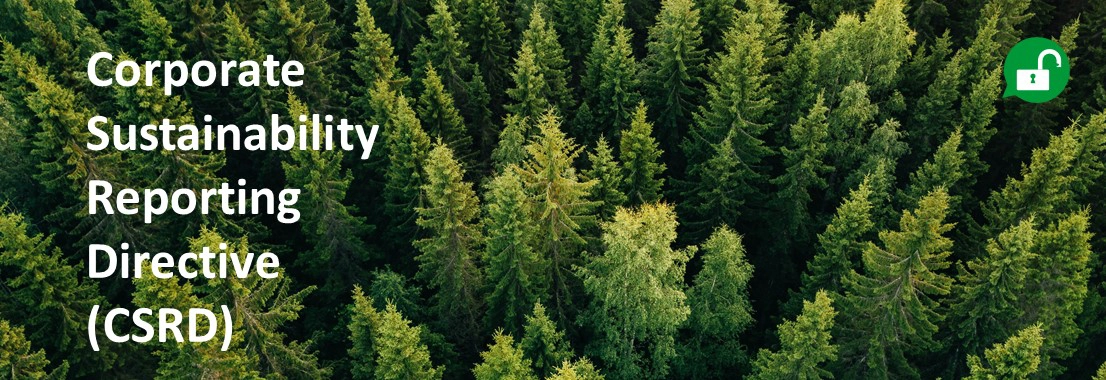
CSRD and OSH reporting
The EU’s new ESG reporting law will affect tens of thousands of companies doing business in Europe. We take a first look at some of the aspects of health and safety reporting and materiality assessment.
Corporate Sustainability Reporting Directive (CSRD)
The Corporate Sustainability Reporting Directive (CSRD) ushers in a new age of sustainability disclosure. Even as voluntary sustainability reporting frameworks spread in previous years and pressure for environmental, social and governance (ESG) management grew from investors and corporate customers, there was little standardisation. The CSRD requires detailed annual reporting on comparable terms across a whole range of sustainability metrics set out in the European Sustainability Reporting Standards (ESRS). The first set of ESRS were drafted for the European Commission by the European Financial Reporting Advisory Group (EFRAG) and will pass into law in January 2024. They cover everything from carbon emissions to equal pay and water resources to trade union bargaining.
The parts of most interest to OSH specialists will be specific disclosure standards for health and safety under the standards ESRS S1 - Own workforce and ESRS S2 – Workers in the value chain. These set the reporting metrics for companies where the health and safety of the workers they employ and contract, or those of their suppliers and customers – who make up their value chain - is “material” to their sustainability.
Some of the documentation for affected businesses was only finalised in recent months and many people in businesses and consultancies are now working on their interpretation and what companies will have to do to comply. But we can draw out some details of what will be expected from companies who fall in the Directive’s scope now or later and how they will decide what to report on.
Double materiality
Though some issues are mandatory for CSRD reporting, such as climate change impacts, health and safety falls into the social category where for many factors businesses in scope have to report on issues that are “material”- important to their operations and to the investors and customers they need to assure about their sustainability. The directive uses the concept of “double materiality”. This requires companies to assess and report on the financial risks and opportunities of a sustainability factor – so called “financial materiality”. But they must also evaluate the factor’s potential or actual effect on people or the environment in the short, medium or long term, so called “impact materiality”.
To assess whether a sustainability factor is material for impact, and to what degree, an organisation is expected to gather evidence. The Annex to the Directive published by the European Commission says the evidence for impact materiality will be “informed by dialogue with affected stakeholders”.
The stakeholder group for impact materiality is a broad church as defined in the guidance. It includes non-governmental organisations (NGOs), social partners - such as trade unions and employee representatives, public authorities and end users of products and services. These stakeholders’ interests are also defined in a broad way, for end users, for example the guidance says they need information on an organisation’s impacts on people or the environment “to guide their decisions in relation to sustainable consumption and development”.
Once an organisation has gathered stakeholder views, draft EFRAG guidance sets out a methodology with tables to assess the factor from “critical” to “minimal” based on the scale of the impact, scope and how easy it is to remediate. If the result of this working out is a rating of critical, significant or important for health and safety, then it is material and should be included in the CSRD report, says the draft.
There will be more detail to come about materiality assessments as the Commission has asked EFRAG to draw up extra guidance on how to decide which standards they have to report on.
The Corporate Sustainability Reporting Directive
After decades in which voluntary standards for disclosing sustainability impacts such as those published by the Global Reporting Initiative (GRI) have grown and grown, The Corporate Sustainability Reporting Directive (CSRD) transfers some of their elements to a statutory footing for companies above a certain size based in or operating in the European Union. The CSRD builds on reporting requirements for large companies under the current Non-Financial Reporting Directive.
The European Commission adopted the CSRD in February 2022 and it came into force in January 2023. In July 2023 the Commission adopted the first set of European Sustainability Reporting Standards (ESRS). The ESRS flesh out the CSRD’s reporting requirements. Their requirements have been aligned where possible with existing standards such as GRI and the new International Sustainability Reporting Standards.
The CSRD’s requirements apply from the 2024 financial year to all EU-based companies which meet two of the following criteria: they have more than 250 employees; a total annual balance of more than 20 million Euros; sales of more than 40 million Euros. Over the four years after, the scope will be expanded to include smaller businesses listed on EU stock markets and non-European companies with net sales of more than €150 million in the EU and one or more subsidiary or branch in EU countries.
Reporting metrics
Under disclosure requirement S1–14 of the ESRS, where a materiality assessment shows that a company should include health and safety as a material factor for its own workforce, there is a set of data it must include in its statement.
The main metrics required are:
- the percentage of total employees covered by the health and safety management system;
- the number of fatalities as a result of work-related injuries and work-related ill health;
- the number and rate of recordable work-related accidents;
- the number of cases of recordable work-related ill health; and
- the number of days lost to work-related injuries and fatalities from work-related accidents, work-related ill health and fatalities from ill health.
There is guidance in the Annex to the Directive and in the ESRS about what should be included and excluded from these figures.
According to Annex 1 to the ESRS, the formula companies use to state the rate of recordable work-related accidents must be to divide the number of accidents by the total number of hours worked by their workforce then divide by 1,000,000 (which equates to the number of hours worked by 500 people in a year). This is the same as one of the formulae prescribed in the 2018 update of the voluntary GRI 403 health and safety standard, but seems unusual for a regulation aimed at European companies where, as in the UK, the more common multiplier is 100,000 hours.
Where the figures for accidents and ill health need improvement, the organisation can report on actions and targets to improve metrics, such as investing in safer equipment or plans to cut accident or illness rates.
There are various phase-in arrangements for parts of the CSRD requirements related to health and safety. One of these is a provision that in the first year of reporting, companies do not have to provide the data on ill health cases and days lost to ill health, and can leave out information on the health and safety of non-employees such as contractors working on company sites.
Value chain impacts
Where value chain health and safety could be a material issue for a business, the data gathering implications are substantial. An EFRAG agenda paper published in November 2023 gives an example of a retailer selling wooden toys made in a factory outside the EU, where legal requirements are lighter. The manufacturing process involves health and safety risks from dust and chemicals. “There is therefore a significant risk that the workers and the local communities are exposed to severe occupational hazard exposures and health risks – important when considering impact materiality,” says the paper.
Where companies have to report on value chain health and safety, there is also an expectation that they will become involved in, and report on, improving standards in parts where they are low. One example the Annex gives of a disclosure is “the undertaking may have a long-term target to achieve an 80% reduction in health and safety incidents affecting the workers of a given supplier by 2030.”
There is also provision that where companies struggle to gather detailed information in detail for companies in their upstream and downstream value chains they can estimate the impacts using proxy sources such as sector averages and data from peer groups.
Publishing requirements
Companies in scope of the Directive have to put all the required information together in a sustainability statement as part of their management report, published at the same time as their annual financial statements, not in a separate sustainability report as many have chosen to do in the past.
Though companies will not have to explain in their CSRD reports their reasoning for deciding health and safety is not material, their materiality assessments will have to be checked and approved by the external auditor who signs off the report. In many cases these auditors will be the same organisations that audit their financial results, though the standards they will have to apply will not be as forensic as those for financial data. The big accountancy firms have been gearing up to provide this audit service.
There are still elements of the way the CSRD will affect organisations to be worked out, for example EFRAG will issue sector-specific ESRSs. But the detail available in the many hundreds of pages of regulation and guidance published to date suggests that businesses in scop will have a busy time assessing materiality and gathering information on their impacts, risks and opportunities.

